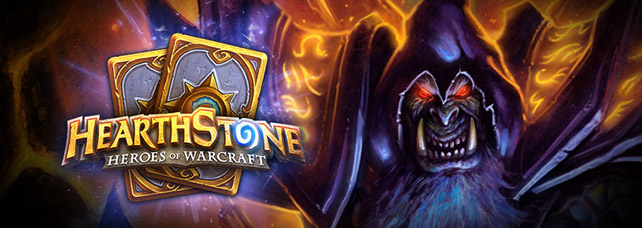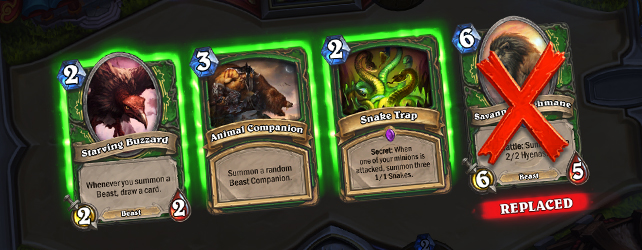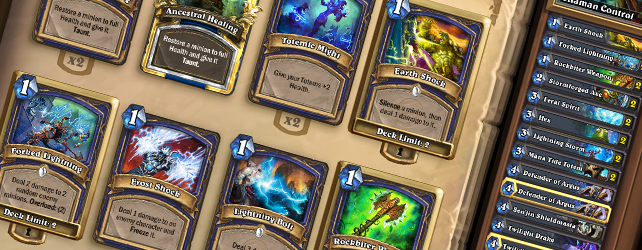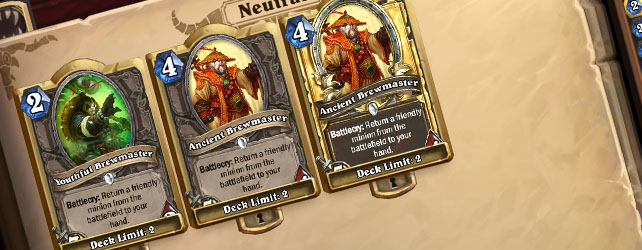Looking for a decent yet affordable deck to start with? I’ve been piloting the Hunter deck mostly to start with as I start climbing my way back up to Masters and on. It’s a straightforward deck and easy to play. It relies heavily on minions to deliver the finishing blow and you have to be able to time your attacks as well as your targets or else it will cost you. Of course, a little luck never hurts either. The great thing about this though is that you’re either going to win fast or lose fast. The only majorly expensive thing is King Krush, but he’s more of a luxury. Scroll down to the bottom to see a narrated video of this in action!
Overview
You’ve got a hunter deck that’s full of mostly beasts. They’re all midrange costing beasts and they all have some utility. Your Ironbeak Owls can help control and ability threats. Your Buzzards help you draw cards. Animal Companions and Ironfur Grizzlies have their own thing going. Your spells consist of ways to either control the board or accelerate into draws you need.
Deck list
The Cards
Flare and Tracking: Tracking is pretty straight forward. Cast it and you can use it to help cycle and fish for options. There a taunt minion in the way? Hope you draw into a Hunter’s Mark or a Kill Command. Low on minions yourself? Fish the next three possible cards for some beasts to help power your offense.
Hunter’s Mark: Such a good card. For one, it’s free. Second, it allows any of your minions to trade with any of your opponent’s creatures. How pissed off are they going to be when their 4/7 Twilight Drake just got brought down to size and taken down with your 1/1 Snake?
Timber Wolf and Unleash the Hounds: Ideally, you don’t want to see Unleash the Hounds in your opening hand. Timber Wolf is a toss up. You can drop it turn 1, but I find it usually gets blown up early game. The +1 buff does come in handy mid to late game as it strengthens the rest of your minions. However, if you have a Buzzard in your hand, you can use it as a way to feed your hand size.
Snake Trap: I’ll almost always play this turn 2. If I can pair it with a Buzzard in play, even better. This deck needs cards to really keep going.
Ironbeak Owl: Do not play these willy nilly. Sit on these until there’s an actual threat on the board or if it can secure you a win. If your opponent’s big tree druid thing is in the way, silence it and let your army through.
Scavenging Hyena: This is insurance. If your opponents take out other minions, your Hyena gets larger. It’ll definitely attract removal because your opponent won’t want this to get large. What do they do if there’s a Buzzard and a Hyena and play with enough mana for only kill?
Starving Buzzard: I’ll almost always play these around turns 4 – 6. I make sure I have at least 1 beast to follow up with it (ideally 2). If possible, you want to try to protect it or make it really hard for your opponent to kill it (like forcing them to decide between that or a Timber Wolf or a Hyena).
Animal Companion: AC is a random card which can give you either Misha, Leokk, or Huffer. They’re all beneficial in their own ways and you’ll find your plays will
Kill Command and Multi-Shot: These are your direct removal spells. Kill Command has the benefit of being used directly against the player. So when calculating the amount of damage output your beasts have, keep this in mind.
Ironfur Grizzly: The Grizzly is like your best friend. Dependable and will usually take a shot for you (or two if you’re lucky). Don’t expect much more out of it then that since it’s mainly supposed to be a meat shield.
Houndmaster: Turns any of your beasts into meat shields. Great well to help defend your Buzzards.
Savannah Highmane: Throw these away from your opening hand if you see them. It’s a dead card until mid to late game anyway. But it plays right into the theme of your deck and provides durability against any board clears.
King Krush: Your finishing blow. Your upper cut. Your People’s Elbow. Your coup de grace. Need I say more?
Playing the deck
Opening draws: Throw away Unleash the Hounds, King Krush, Savannah Highmanes. You should definitely keep Tracking, Buzzards, Snake Traps, and almost every other minion. Keep Flare against mages, paladins, and other hunters. Keep Kill Command and Multi-Shot against hunters, warriors, and priests.
Everything you do should be used to either go straight to the opponent’s face, clear a path to your opponent’s face, or eliminate any threats that are bigger then you. Certain classes will give you a harder time than others. Know what other class capabilities are and identify what spells they have which can be used against you and play accordingly. Priests have Mind Control. Bait out your 4/3 Starving Hyena so they won’t steal your Highmane when you drop it next turn.
Know when to hold your beasts. If you already have board supremacy (like 3+ creatures) and are in good position, don’t overplay your hand! Your opponent might have a mass removal spell. Suddenly, those extra hyenas and owls you played are dead for no reason because you didn’t have to play them. If all your minions are dead, you have no other offense and you’re in top deck mode. Playing against a mage? Watch out for Blizzard. Against Warlocks? Hold them against Hellfire.
Your hero power is straight forward. 2 mana, 2 damage to the other player. Use it if you have nothing else to do. You should be able to get a few early ones in during the early and late game stage.
Learn how to maximize your minions abilities. For example, the Grizzly’s taunt is great at attracting attention. Your opponent must go through it. So if your opponent has a 4/3 on board without a taunt staring down your Grizzly, and it’s your turn, what should you do? You can attack into the 4/3 and suicide it. Or you can attack your opponent directly and let them attack into your Grizzly. In both scenarios, the opponent’s minion and your Grizzly are both dead. But in the second case, both are dead and you dealt 3 damage to your opponent resulting in steps closer to a win.
If you’re playing from behind, there is some hope but it depends on what your disadvantage is. If you’re behind on cards (as in your opponent has more cards in your hand then you) and a neutral board, it’s not going to look good. Don’t worry about your life total as much so long as it’s above zero, you’re okay. The strength of Hunter decks is based on their ability to burst opponents down in a turn or two. Well timed minion drops with an Unleash the Hounds can help tremendously even the score and even bring it back in your favor. Buzzards are the key to digging yourself out of a hole.
Good luck and good hunting!
buy zimulti
buy furosemide online



